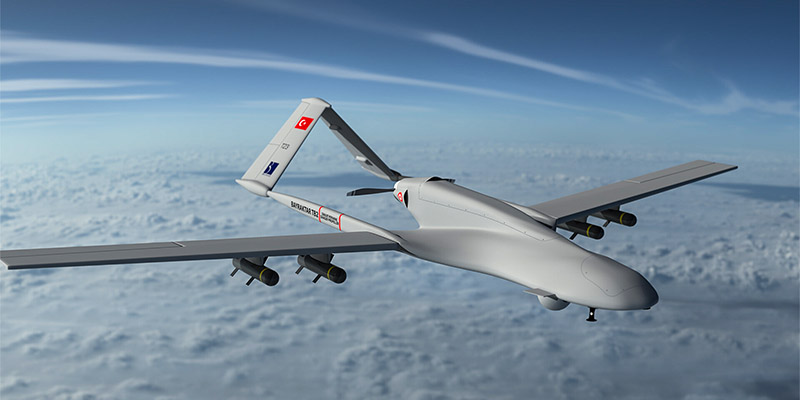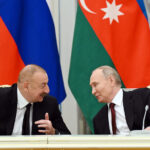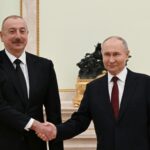Azerbaijan used the Turkish Baykar Bayraktar TB2 armed drone against the Armenian armed forces to great effect in the 2020 Nagorno-Karabakh war. Turkey also supplied the TB2 to Ukraine which successfully used them to strike Russian army formations.
In Ukraine, the Russian armed forces are using the Iranian Shahed-136 drones to attack the power grid, water pipelines, rail lines, dams, and other critical infrastructure. Russia denied using them, while Iran was coy, official denials alternating with leaders bragging about the capability Iran’s weapons before the foreign minister finally admitted that a “limited number” of drones were supplied to Russia, not that it mattered as the U.S. had already sanctioned the Iranians it claimed supplied the drones.
Aside from the sale to Azerbaijan, Turkey has sold drones to Ethiopia, Morocco, Kyrgyzstan, Qatar, Saudi Arabia, Turkmenistan, Pakistan, and Pakistan’s rival India, and deployed them to Syria in support of its forces. Lately, Turkey and the interim Libyan government in Tripoli signed a military cooperation agreement that may see the sale of drones to the Tripoli administration, which was likely impressed by the performance of Turkey’s armed drones against the rival Libyan National Army which used the Chinese Wing Loong drone.
Libya has been called “ground zero for drone wars,” a place where Turkey and China can demonstrate their wares by arming opposing sides in the civil war. It’s the modern version of the “Win on Sunday, sell on Monday” philosophy behind factory-backed motor racing teams, but in this venue the contestants are the Turkish TB2 and the Chinese Wing Loong. But, despite the aura of precision, the belligerents haven’t fared any better than any other drone users, including the U.S., in one case attacking a town hall meeting, killing 45.
In Turkey, U.S.-trained engineer Selçuk Bayraktar is known as the “godfather of drones” for designing the Bayraktar TB2 drone, but the real reason Turkey is in a place of opportunity is the 1975 U.S. arms embargo of Turkey following its intervention in the conflict between Greek and Turkish Cypriots. The embargo energized Turkey to expand its local arms industry and it advanced to the point where Turkish companies were key suppliers for the fifth-generation F-35 Lightning II combat aircraft.
In 2021 Turkey exported arms to 169 countries, including the U.S., Azerbaijan, the United Arab Emirates, and Germany. The TB2 is being sold to 24 countries including NATO member Poland, and Baykar has agreed to sell the larger Akinci (“Raider”) drone to five countries. Turkey will continue to expand its industry to avoid future supply cutoffs and to bolster its drive to be the regional leader in the Caucasus and Central Asia. In 2021, the TB2’s maker, Baykar, earned a fifth of Turkey’s $3.2 billion in defense exports, which showed a 41.5% jimp from $2.3 billion in 2020, and which may exceed $4 billion in 2022.
Turkey is also transferring drone manufacturing facilities to Ukraine, Kazakhstan, and the United Arab Emirates (UAE).
The Ukraine factory is expected to be complete by late 2024, and Kazakhstan will produce the Turkish Aerospace Industries Anka (“Phoenix”) medium-altitude, long-endurance drone in a collaboration that will include technology transfer, maintenance, and repairs. The UAE purchased 120 TB2s for $2 billion, to include smart munitions, ground control stations, training, and the possible production of some components in the emirate.
Iran’s Shahed-136 drone, which was tested in Yemen, made a dramatic entrance in Ukraine in October as Russia attacked cities, power plants and other infrastructure. They are low-cost, priced between $20,000 to $60,000 each (though David Goldman claims $1,000 each), and a dozen can he had for the price of one U.S.-supplied Switchblade drone.
Whatever the true cost, they’re cheap, and Ukraine is using a lot of expensive American-supplied weaponry to try to bring them down.
Iran provided drones to the Houthi rebels in Yemen, where they were reportedly a “game changer” since their introduction in 2016, and to Hezbollah in Lebanon. The Islamic Republic set up drone factories in Tajikistan and Syria, though the latter was destroyed by Israel in October.
Iran turned to drones out of necessity as it was unable to develop an effective air force, so drones became one of the four pillars of Iran’s military strategy, the others being the missile program, its network of non-state allies and proxies, and its growing cyber warfare capabilities.
Due to sanctions and the West’s campaign of economic warfare, Iran focused on indigenous production and took advantage when copies of U.S. gear fell into its hands, such as the 2011 downing of an RQ-170 Sentinel reconnaissance drone and the 2019 shootdown of a RQ-4A Global Hawk surveillance drone. Recent reporting claims Iran is using Chinese knock-offs of Western parts in the Shahed-136. Iran may be unable to source everything it needs internally or from other countries but that’s immaterial as China won’t stop trade with Iran, and Iran is gaining leverage with Russia (and other potential buyers) whatever the provenance of some of the internals.
Iran has made real progress since starting its drone program in the 1980s during the war against Iraq, but will it be able to match Turkey’s success? Probably not, as Turkey has a larger and more diversified economy, is a member of NATO, and has a well-developed infrastructure that has made it the leading candidate to be the energy and transport hub for the region.
Next-level success in the drone business will come not from bigger weapons payloads or longer range, but from developing and deploying the systems necessary to collect and analyze data that can be turned into a targeting solution. In this place, advantage Turkey for the above reasons which ensure little to no transaction risk, something Iran can’t claim.
However, Iran has developed a significant ballistic missile portfolio and has an advanced nuclear research program, so there’s that…
The development and proliferation of military drones by Turkey and Iran has developed more sophisticated supply chains.
When Iran and Turkey developed drones, they not only learned how to make many of the parts but also forged relationships with foreign parts suppliers. As defense articles were being exchanged, the bilateral relationship was potentially stronger than if they were buyer and seller of consumer electronics or white goods. The seller knows he may be taking sides in the buyer’s next fight, so will weigh carefully the sale before it is made, however the supply may still be cut off if the buyer engages in behavior that severely conflicts with the seller’s norms or political objectives.
NATO member Turkey was able to go in the front door and sourced some drone parts from Canada (electro-optical and infrared cameras), the United Kingdom (UK) (missile racks), and Ukraine (engines). Canada and the UK shut down the pipeline when Turkish drones were used by Azerbaijan against Armenian forces in 2020. Also in 2020, Turkey backed away from its Ukrainian supplier and substituted a domestic engine. Selçuk Bayraktar, Baykar’s chief technical officer, denied that Baykar had purchased the Hornet rack from Britain and claimed it had designed its own “much more advanced model at an affordable cost.” In early 2022, Turkey announced it had equipped the TB2 with a locally-built electro-optical system.
Turkey was able to benchmark the performance of imported parts, maybe do a little reverse engineering and, when the suppliers were no longer cooperating, substitute local content.
Iran isn’t in the same position as Turkey and has had to refine its skills in covert finance, use of informal transport systems, and infiltration and subversion to source many of the parts and materials it couldn’t make itself. There are unique “channels” of sellers, shippers, and don’t-see-anything officials unique to the covert supply of parts for each type of weapon, be it drones, ballistic missiles, or combat aircraft. Thus, the more weapons Iran had to develop against embargoes, the more foreign partners it created and the more its businessmen and officials learned to evade sanction and embargo.
For example, Austrian Rotax aircraft engines were discovered in Iranian-made Mohajer-6 surveillance drones downed over Ukraine. The sale of the engines violated European Union sanctions on Iran, and it is believed the engines are the target of an organized, worldwide theft campaign. Sanctions and embargos slow the development of weapons by Iran, but Tehran’s security services probably use criminal rings to steal the material and, in the process, develop new relationships that may be used in future operations.
In a similar vein, it is believed Russia is behind the theft of over 175 speed cameras from Sweden. Ukrainian forces discovered a similar type speed camera in a home-made Russian drone sent to spy on Ukraine.
Also important for the buyers is learning to exploit data harvested by the drones. The seller may provide a process to capture, store, and transmit data to storage in the customer’s country, or the customer may elect to use storage and analysis services provided by the seller. The buyer may use the data to support military operations, diplomacy, trade, environmental protection, wildlife conservation, and natural resources exploitation.
The buyer may store the data outside the country or in “the cloud,” but that’s just another name for someone else’s computer. Any seller – the U.S., Russia, China, Turkey, or Iran – will use its access to the customer data to spy on the buyer, so the buyer may as well just go with the vendor that won’t limit its political options. And all those civilian technicians and trainers provided by the seller are reporting back to their government, regardless of what their contracts say.
Drone proliferation also affects and limits choices available to Washington and its allies.
The introduction of drones into war zones may prolong a conflict, weakening economies and governments, and causing instability, poverty, and out-migration, which are themselves weapons. The U.S. may act against, say, Iran and its customer, but the action against the third-party may conflict with, and complicate, other regional priorities, which may work to the satisfaction of Tehran.
And to keep its fingerprints off a transfer, Iran might teach it acolytes how to make a simple drone, give them a parts list and a bag of money, and turn them loose. This is higher risk than a formal supply effort with embedded trainers and technicians reporting back to Tehran, but unique demands for deniability may make this a viable, but limited, option.
Drone proliferation may see a rise in targeted killings, mimicking the U.S. and Israel, the leading practitioners. Drones offer advantages, such as not putting a ground team at risk (no POWs or crying mothers), as Israel learned to its embarrassment in 2010 when the Dubai police publicly identified most of the members of an assassination squad that killed Hamas leader Mahmoud Al-Mabhouh.
The targets may quickly figure out who was behind a drone attack, such as from ordnance fragments, but the attacker can easily deny everything, claiming it’s all “fake news,” while benefitting from the “demonstration effect” of the attack.
Drones may keep a conflict at a lower temperature, avoiding troop movements which are synonymous with as “war,” while appearing to act in a surgical, discriminate fashion. Drones may also allow one side to avoid a trap by an outside power by not deploying large numbers of troops to settle a dispute.
However, drones may encourage action at an earlier stage of a conflict, before troops are fully mobilized or political buy-in from neighbors or the big powers is secured. Problem is, while drones have the look and feel of a tuned instrument, events will inevitably get away from the belligerents and they may be caught in an escalatory spiral earlier than if they waited to mobilize troops, in which time diplomatic opportunities may have become available.
And, despite the image of drones as precise killers they really aren’t.
The UK human rights group Reprieve found that U.S. drone strikes on 41 terrorists in Pakistan wound up killing 1,147 people. For example, the U.S. tried five times to kill Qari Hussain, a deputy commander of the Pakistani Taliban unknown to all but a dozen Americans, before getting lucky the sixth time, but in the process killing 128 unlucky people, 13 of them children. And it’ll be a long time before anyone forgets that, on its way out the door in Afghanistan, the U.S. mistakenly killed the 10 members of an innocent Afghan family, believing they were members of the terror group IS-K.
And the U.S. has the best targeting and intelligence information, so anyone else’s efforts won’t be any less woeful. And when that happens, they can just claim the staff judge advocate agreed it was a “legitimate military target,” announce an investigation that will find “mistakes were made” but no one did anything wrong, offer compensation, and move on. And why not? It worked for 20 years in Iraq and Afghanistan…
One matter of concern for national governments, and the U.S. specifically, is the use of drones by criminal gangs, warlords that control access to natural resources, and state-sponsored militia groups that slip the leash.
In Mexico and Latin America, drug cartels are using drones for the same tasks as state militaries: Intelligence, Surveillance, and Reconnaissance; and attack. And the cartels, being savvy users of social media, have publicly announced their ability to drop bombs on rival gangs. The cartels have no compunction about killing state officials so they will use drones in ever more sophisticated attacks on state institutions and, potentially, on U.S. officials.
In November 2021, Iraq’s Prime Minister, Mustafa al-Kadhimi, survived a drone attack mounted by an Iranian-sponsored militia. The attack was opposed by the group’s Iranian sponsors, but demonstrated that even state-level sponsors can’t always control their proxies who invariably develop their own objectives.
Iran and Turkey, despite embargoes and sanctions, developed drones through hard work and begging, borrowing, and stealing what they could. As a result, they developed signature weapons that are sources of pride, export earnings, and political leverage.
So, drone proliferation will see increased cooperation between Iran and Russia, while Turkey forges its own path which may or may not comport with U.S. or NATO objectives. And drones offer local politicians a way to claim the country has achieved “defense sovereignty,” even if some of the pieces and parts are imported, giving a boost to state-controlled defense companies, such as the UAE’s EDGE Group, or Turkish Aerospace Industries.
Technology is a democratizing force. Governments are all for it when it allows favored activists to tweet against a detested regime, but not so much when a country may take unilateral military action Washington may disapprove of or be unable to control. Drones are a negligible threat to the U.S. homeland, but their proliferation will be characterized as against “American interests,” which are often just the priorities of the current Washington administration.
On the other hand, drone proliferation will suit some Americans just fine. An increased drone “threat” will be used to justify buying more advanced drones that can kill opposition drones in the air, and ground-based counter-drone systems. Then, policy officials and legislators can mobilize export control and sanctions mechanisms to punish miscreant buyers and sellers. The Pentagon and its contractors will enjoy a good payday, while the politicians claim the moral high ground against proliferation. Nice work if you can get it.
James Durso, is a regular commentator on foreign policy and national security matters. Mr. Durso served in the US Navy for 20 years and has worked in Kuwait, Saudi Arabia, and Iraq.










